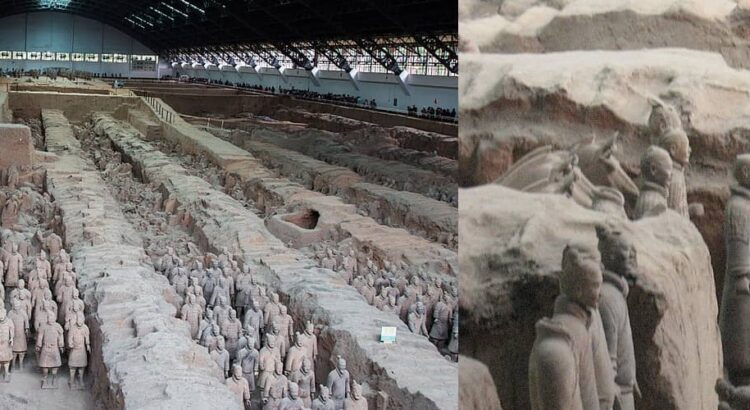The Terracotta Army, situated in China’s Shaanxi province, is a remarkable archaeological marvel that dates back over two thousand years. Comprising thousands of life-sized terracotta sculptures, it portrays soldiers, horses, chariots, and military equipment. This vast collection was buried close to the tomb of Qin Shi Huang, the first Emperor of China, with the intention of protecting him in the afterlife.
Its discovery in 1974 by local farmers digging a well sparked global fascination due to its immense scale and exquisite craftsmanship. Each soldier features distinct facial expressions, hairstyles, and armor, indicative of the artistry and attention to detail of ancient craftsmen during the Qin dynasty. Experts estimate that the site contains over 8,000 soldiers, along with chariots, horses, and various other figures.
Beyond its artistic and historical significance, the Terracotta Army provides invaluable insights into ancient Chinese military tactics, weaponry, and societal structures. It serves as a testament to Qin Shi Huang’s aspirations and authority, immortalized through these clay representations. Today, recognized as a UNESCO World Heritage site, it stands as a symbol of China’s rich cultural heritage, attracting millions of visitors worldwide who come to admire its magnificence and unravel its mysteries.
Where can I see the Terracotta Army, How to reach
To reach the Terracotta Army, travelers typically journey to Xi’an, the capital city of Shaanxi province, China. Xi’an boasts excellent connectivity via air, rail, and road networks.
For those traveling domestically within China, the most common route is flying directly to Xi’an Xianyang International Airport from major cities such as Beijing, Shanghai, Guangzhou, and Chengdu. Upon arrival, transportation options to the Terracotta Army site, located approximately 40 kilometers northeast of the airport, include taxis, buses, or arranging private transfers.
If already in Xi’an, several transportation choices exist to reach the Terracotta Army site:
- Bus: Public buses departing from the Xi’an Railway Station, Xi’an North Railway Station, and various city locations operate regularly to the Terracotta Army Museum. Look for buses heading towards “兵马俑” (Bingmayong), the Chinese name for the Terracotta Army.
- Taxi or Didi: Taxis and ride-hailing services like Didi are readily accessible in Xi’an. Travelers can hire a taxi or use the Didi app to arrange transportation directly to the Terracotta Army site.
- Tours: Numerous tour companies in Xi’an offer guided tours to the Terracotta Army, often incorporating visits to other local attractions. This option provides convenience and the opportunity to benefit from knowledgeable guides.
Upon arrival at the Terracotta Army site, visitors must purchase tickets for museum entry to explore the archaeological wonder and delve into its historical significance through informative exhibits.
What was the Terracotta Army
The Terracotta Army represents an exceptional assembly of terracotta sculptures discovered adjacent to the tomb of Qin Shi Huang, the inaugural Emperor of China, dating back over two millennia. Unearthed in 1974 by local farmers in Shaanxi province, this collection comprises thousands of meticulously crafted figures, including soldiers, horses, chariots, and various other artifacts.
Created during the Qin dynasty, these sculptures were interred with Emperor Qin to serve as guardians in the afterlife. Each figure boasts distinctive facial characteristics, hairstyles, and armor, showcasing the unparalleled skill of ancient Chinese craftsmen. Additionally, the site features chariots and non-military sculptures, shedding light on the military and societal structures of the Qin era.
The discovery of the Terracotta Army has not only captivated global audiences with its grandeur and artistic excellence but has also provided invaluable insights into ancient Chinese civilization. Recognized as a UNESCO World Heritage site, it serves as a testament to China’s rich cultural heritage and attracts millions of visitors annually, offering them a glimpse into the historical significance and magnificence of the ancient past.
Where is the Terracotta Army in China, Maps and location
The Terracotta Army is situated near Xi’an in China’s Shaanxi province, specifically in the Lintong District, approximately 40 kilometers northeast of downtown Xi’an. This archaeological site forms part of the expansive Mausoleum of the First Qin Emperor complex, which also houses the tomb of Qin Shi Huang, China’s inaugural Emperor. Renowned globally as a cultural marvel, the Terracotta Army attracts numerous visitors annually, drawn by its historical importance and remarkable craftsmanship.

Things to do at the Terracotta Army
Exploring the Terracotta Army offers a plethora of enriching experiences for travelers eager to delve into China’s historical and cultural tapestry:
- Discover the Pit Complex: Meander through the excavated pits housing the terracotta warriors, horses, and chariots. Admire the impressive scale and intricate craftsmanship of these ancient sculptures.
- Museum Exploration: Delve deeper into the history and significance of the Terracotta Army at the museum on-site. Exhibitions showcase unearthed artifacts, providing valuable context to the Qin dynasty era.
- Witness Archaeological Endeavors: Observe ongoing archaeological efforts as experts continue to uncover and preserve new findings. Witnessing the restoration process offers insights into ancient craftsmanship techniques.
- Cultural Performances: Immerse yourself in traditional Chinese performances, including music, dance, and theater, frequently staged at the museum complex, enriching your visit with cultural vibrancy.
- Explore Nearby Attractions: Take advantage of nearby attractions like the Mausoleum of the First Qin Emperor, Huaqing Palace, or the historic city of Xi’an, renowned for its ancient city walls and vibrant Muslim Quarter.
- Hands-On Engagement: Participate in workshops offering opportunities to try traditional crafts like pottery-making or calligraphy, fostering a deeper connection with Chinese culture and artistic traditions.
- Capture Memories: Document your visit with plenty of photographs, capturing the essence of this UNESCO World Heritage site and sharing your experiences with loved ones.
Engaging in these activities enables visitors to fully immerse themselves in the historical significance and cultural richness of the Terracotta Army, creating cherished memories of their exploration through ancient China.
Things not to forget when visiting the Terracotta Army
When planning your visit to the Terracotta Army, consider the following essential reminders to ensure a pleasant and hassle-free experience:
- Admission Tickets: Make sure to purchase your admission tickets either in advance or upon arrival at the site. This will grant you access to the museum complex and the various pits housing the terracotta sculptures.
- Footwear: Opt for comfortable footwear suitable for walking and exploring the expansive site. Some areas may have uneven terrain, so wearing comfortable shoes will allow you to navigate comfortably.
- Sun Protection: Remember to bring sun protection such as sunscreen, a hat, and sunglasses, particularly during sunny days. Shielding yourself from the sun will help prevent sunburn and discomfort during your visit.
- Hydration and Snacks: Carry a water bottle and some snacks to stay hydrated and energized throughout your exploration. While facilities are available, having your own refreshments ensures you can rehydrate and refuel whenever necessary.
- Camera or Smartphone: Don’t forget to bring along your camera or smartphone to capture the highlights of your visit. The Terracotta Army offers plenty of picturesque scenes worth documenting.
- Appropriate Attire: Dress respectfully for your visit, bearing in mind the cultural and historical significance of the site. Avoid clothing that is overly revealing or inappropriate for a cultural excursion.
- Respectful Conduct: Practice patience and respect towards fellow visitors, especially in crowded areas. Take your time to admire the sculptures and exhibits, and adhere to any guidelines provided by staff.
By keeping these points in mind, you can ensure a memorable and respectful visit to the Terracotta Army, fully appreciating its historical and cultural significance.
The best time to visit the Terracotta Army in Xi’an, China
The optimal time to visit the Terracotta Army in Xi’an, China, is during the spring and autumn seasons, specifically from April to May and September to October. These periods offer mild and comfortable weather conditions, with pleasant temperatures and minimal rainfall, making it ideal for exploring the outdoor archaeological site.
During spring, from April to May, visitors can enjoy mild temperatures and lush greenery, creating a picturesque setting for their exploration. Moreover, the smaller crowds compared to peak summer months allow for a more tranquil and enjoyable visit.
Similarly, autumn, from September to October, provides mild temperatures and clear skies, enhancing the overall experience of visiting the Terracotta Army. The colorful foliage adds to the scenic beauty, offering visitors an unforgettable experience.
It is advisable to avoid the peak summer months of June to August, as the weather tends to be hot and humid, with higher chances of rainfall. Additionally, these months attract larger crowds, resulting in longer wait times and more crowded conditions at the site.
Ultimately, choosing to visit during the spring or autumn seasons ensures an optimal balance of favorable weather, fewer crowds, and breathtaking scenery, guaranteeing a memorable and rewarding experience at the Terracotta Army.
What is so special about the Terracotta Army?
The Terracotta Army stands out for numerous exceptional characteristics that distinguish it as one of the most extraordinary archaeological finds globally:
- Immense Scale: The sheer magnitude of the Terracotta Army is breathtaking, consisting of thousands of life-sized terracotta sculptures, including soldiers, horses, chariots, and other figures, meticulously arranged in battle formation across multiple pits.
- Historical Significance: Originating over two millennia ago during the Qin dynasty, the Terracotta Army was commissioned to accompany Qin Shi Huang, China’s first Emperor, into the afterlife. This reflects ancient Chinese beliefs regarding the afterlife and underscores the significance of serving and safeguarding the emperor beyond death.
- Exquisite Artistry: Each terracotta soldier exhibits remarkable craftsmanship, featuring distinct facial expressions, hairstyles, and armor. These intricate details highlight the exceptional talent and skill of ancient Chinese artisans and offer insights into Qin-era military attire and weaponry.
- Ingenious Construction: The discovery of the Terracotta Army unveiled sophisticated engineering methods employed in its creation. From meticulous sculpting to kiln firing and precise assembly, the site showcases advanced techniques that ensured the sculptures’ preservation over centuries.
- Historical Insights: Beyond its artistic value, the Terracotta Army provides invaluable glimpses into ancient Chinese history, military strategies, and social structures during the Qin dynasty. It offers a window into the reign of Qin Shi Huang and the organizational prowess of his era.
- Cultural Heritage: Designated as a UNESCO World Heritage site, the Terracotta Army holds immense cultural significance for China and the world at large. It serves as a tangible symbol of China’s rich cultural heritage, drawing millions of visitors annually and embodying the country’s ancient civilization and artistic achievements.
In sum, the Terracotta Army’s blend of historical importance, artistic brilliance, and cultural resonance renders it a truly exceptional and iconic archaeological marvel.
Why was the Terracotta Army lost? – History of the Terracotta Army
The disappearance of the Terracotta Army from historical records for centuries can be attributed to several factors:
- Burial and Secrecy: Following the death of Qin Shi Huang, the Terracotta Army was buried near his mausoleum, intended to accompany him in the afterlife as per ancient Chinese burial customs. The burial was conducted in secrecy, and the site was meant to remain hidden and undisturbed.
- Natural Forces: Over time, natural phenomena like earthquakes and floods might have played a role in concealing the Terracotta Army. These events could have altered the landscape, leading to the burial pits being covered by layers of sediment and debris.
- Human Actions: It’s possible that subsequent rulers or individuals in ancient China intentionally concealed the burial site of the Terracotta Army. Political instability and power struggles following the collapse of the Qin dynasty might have motivated efforts to erase or obscure Qin Shi Huang’s legacy.
- Lack of Documentation: The existence of the Terracotta Army was not documented in historical records, and knowledge of its existence gradually faded over time. Without written accounts or oral traditions to preserve its memory, the site slipped into obscurity until its accidental rediscovery in 1974 by local farmers digging a well.
In summary, the Terracotta Army’s disappearance from historical awareness was a result of intentional burial, natural events, human interventions, and the absence of recorded documentation. Its remarkable rediscovery in modern times has since brought it back to prominence as one of the most significant archaeological finds in history.
Why is the Terracotta Army a mystery?
The Terracotta Army is surrounded by mystery for several compelling reasons:
- Purpose of Creation: Although it’s widely believed that the army was crafted to accompany Qin Shi Huang, China’s first Emperor, in the afterlife, the precise reasons and symbolism behind its construction remain a subject of scholarly debate. The intricacies of why such a massive army was fashioned and interred with the emperor, as well as the significance of the individual sculptures, continue to elude researchers.
- Artistic Complexity: Renowned for its extraordinary artistic intricacy, each terracotta soldier boasts unique facial features, hairstyles, and armor. The complexity of its craftsmanship raises questions about the methods and technology utilized by ancient craftsmen, as well as the level of central planning and coordination required for such an ambitious endeavor.
- Discovery of the Site: The accidental unearthing of the Terracotta Army in 1974 by local farmers digging a well added to its mystique. The unexpected nature of the discovery, coupled with the immense scale and detail of the sculptures, ignited global curiosity and fascination.
- Hidden Secrets: While the Terracotta Army is the most prominent aspect of the burial site, ongoing archaeological digs continue to uncover new revelations and mysteries. Unexplored sections of the site and the potential existence of additional buried artifacts contribute to the ongoing allure and enigma surrounding the site.
- Historical Context: The Terracotta Army hails from ancient China’s Qin dynasty, a period marked by significant political, social, and cultural transformations. Piecing together the context in which the army was fashioned and entombed necessitates synthesizing fragmented historical records and archaeological evidence, deepening the mystery surrounding its origins.
In summary, the Terracotta Army remains shrouded in mystery due to uncertainties surrounding its purpose, the intricacies of its creation, the circumstances of its burial, ongoing archaeological revelations, and the broader historical context in which it emerged. Despite extensive study and excavation, numerous questions persist, contributing to its enduring allure and intrigue.
How many soldiers are in the Terracotta Army?
The Terracotta Army comprises an estimated over 8,000 terracotta soldiers, along with various other sculptures like horses, chariots, and non-military figures. Crafted over two millennia ago during the Qin dynasty, these soldiers were buried near the mausoleum of Qin Shi Huang, China’s first Emperor, with the intent of safeguarding him in the afterlife. While ongoing archaeological excavations may slightly adjust this count and reveal new discoveries, the figure of over 8,000 terracotta soldiers is widely acknowledged as the approximate number housed within the Terracotta Army complex.
Image credits: en.wikipedia.org





